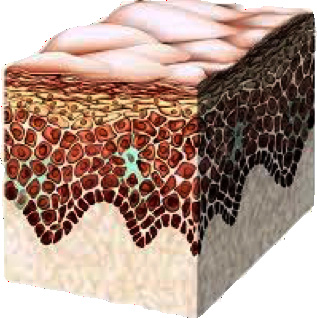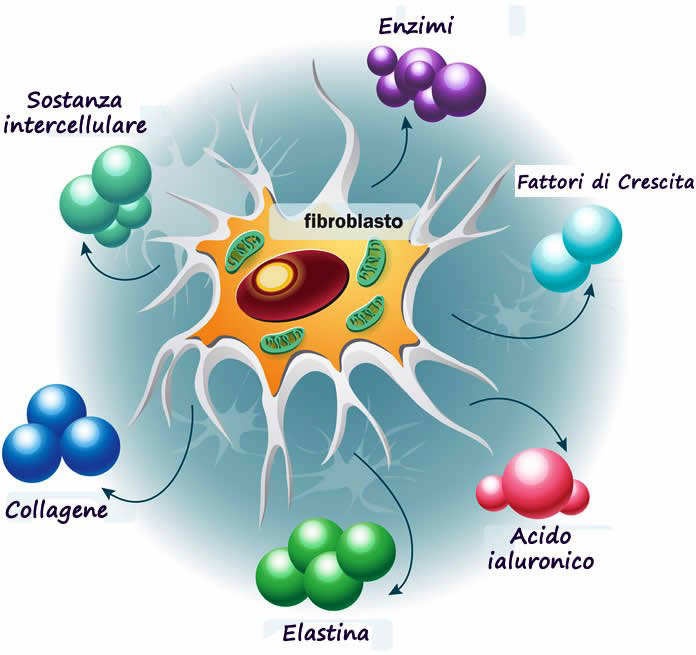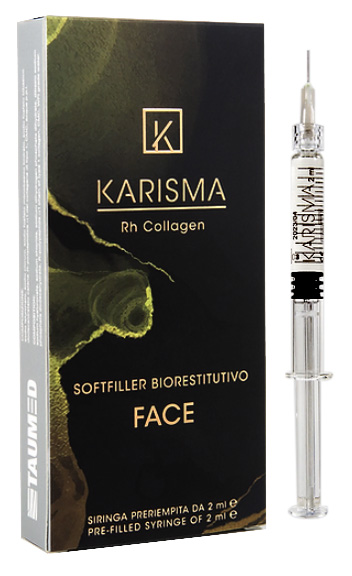KARISMA®
RH
COLLAGEN
The First
and Only Injectable
RH Collagen
The greatest invention
for a clear face
Home Page » Healthcare Professionals
Please click Where You Like to Go
Collagen progressive bio-restructuring.
New therapeutic approaches from Pre-Aging to Anti-Aging

Skin
External Layer:
Internal Layer:

Epidermis

Maintain the correct thickness
Mitosis adjustment
Differentiation of keratinicites

Derma

- Maintenance of the colloidal state of the matrix
- Fibroblast site/home
- Synthesis of its structural components
Fibroblast


The Main components of the Dermis

- Collagen
- Elastin
- Hyaluronic Acid
COLLAGEN
- Collagen accounts for 75% of the dry weight of the dermis.
- Collagen has a rigid structure, the rigidity of which is conferred by proline and hydroxyproline.
- In the hydroxylation of proline we need 2 Co-factors:
- ASCORBIC ACID
- ALPHA KETOGLUTARATE CO-SUBSTRATE
- The most abundant Collagen type in the Dermis is Collagen type I formed by 3 left-handed α chains (2α1 and 1α2) that form a triple right-handed helix.
Biosynthesis of collagen takes place
↓↓↓
Procollagen
↓↓↓
Translation of the RER at the Ribosome level
↓↓↓
Post translational modifications
(PROLINE and LYSINE hydroxylization)
Procollagen Chain(α) formation

Destiny of the Triple Helix

- It passes into the Golgi apparatus where it is glycosylated.
- It is excreted outside the cell where it undergoes further modifications
- Procollagen becomes Tropocollagen
- Tropocollagen arranges in parallel rows forming fibrils
- Fibrils arrange in wavy or parallel bundles to form collagen fibers
COLLAGEN
- Maintains skin tone and elasticity
- After the age of 40 Collagen decreases by 1% every year

ELASTIN
Mechanical Strength:
Resilience:

Elastin
Responsible for the elastic characteristics of organs and tissues.
It Is Rich Of:
- Glycine
- Proline
- Yalina
- Alanine
- Lysine
It is synthesized in Fribroblasts
HYALURONIC ACID
- It is a non-sulphured glycosaminoglycan without a protein core.
- Produced by thousands of disaccharide units formed by residues of Glucuronic Acid and NAcetylglucosamine.
- It has high polarity and water solubility.
GAG
- Molecules composed mainly of unbranched disaccharide units.
- The most important GAG is Hyaluronic Acid
- It represents 0.1-0.3% of the dry weight of the Derma.
The most important GAG is Hyaluronic Acid

Hyaluronic Acid
- Determines tissue hydration.
- Orients the collagen fibers.
- Regulates cell synthesis and differentiation.
- It binds to inflammatory cytokines.
Collagen
↓↓↓
75% of the dry
weight of the Derma
Hyaluronic
Acid
↓↓↓
0,1% – 0,3% of the
dry weight of the
Derma
Collagen decreases in time
For this reason we must induce Fibrobalsts to produce new Type I Collagen

Product Knowledge
Karisma Biorepleneshing Soft Filler
- Addition of the R-polipeptidic α1 chain
- High weight Hyaluronic Acid
- Carboxy methylcellulose

Rh Collagen
- Hydroxylated α1 chain
- Generated by silkworms which synthesize type I collagen in α1 chains and excreted in cocoons
- Low risk of allergic reactions (99.9% similarity to human collagen)
- High solubility

Why the Silkworm?
- Silk is a material used successfully in the medical and surgical fields (sutures) and in cosmetology (silk powder).
- Silkworms are extremely capable in terms of protein production.
- Significant quantities of high quality procollagen can be produced through the expression of procollagen in the sericin layer of the silk thread.
- This procollagen is made up of the same amino acid chain (the human α1 collagen chain) found in collagen synthesized in the human body.

R-Polipeptidic α1 chain
- Increases the production of collagen type I C peptide in Fibroblasts.
- Stimulates and facilitates the winding of procollagen triple helix chains.
- The increase of these free propeptides (polypeptide α1 R chain) stimulate the synthesis of collagen molecules.

Bio-restructuring with Rh Collagen
It is a restorative process that leads to:
- Inflammation which induces the production of the Beta 1 transforming growth factor which stimulates the production of Fibrotic Collagen.
- The stimulation of CD 39 and CD 40 leads to the formation of Fibroblast in Fibrotic Fibroblast and consequent new formation of Fibrotic collagen.
- The production of type I collagen will produce tissue retraction with a consequent lifting effect, greater skin tone and texture due to a qualitative and quantitative increase in collagen fibers.
Collagen type I Triple Helix formation

Polipeptidic alfa 1 Chain R
- Assembly of collagen fibrils and other multimetric structures.
- Biosenthesis and enzymatic modification of collagen.
- Organization of the extracellular matrix thanks to specific receptors.
- Formation of specific subcellular structures involved in the mediation of extracellular matrix signals.
- Participation of inflammatory response processes.
- Platalet activation.
Macromolecular Hyaluronic Acid
- Hydration and maintenance of an environment favorable to the proliferation and metabolism of fibroblasts.
- Antioxidant action.
Carbxymethyl Cellulose
- It inhibits the action of the hyaluronidase enzyme.
- Preserves endogenous hyaluronic acid.
- Slows down the action of MMPs.
KARISMA BIOREPLENESHING SOFT FILLER
- Rh Collagen
- CMC
- HA
- 2 ml Pre-filled syringe

- The suggested protocol is 2 sessions, 30-day intervals.
- Timing of the 2 treatments is essential because the protocol follows the cellular turnover that usually happens every 28 days.
- It is possible to repeat the treatment or the protocol after 4 months.
- The treatment lasts approximately 30 minutes depending on the Area to be treated
Point Technique
- Superficial and medium dermal injection

Retrograde Linear Technique
Insert the needle at the desired depth, parallel to the skin plane,
along the course of the wrinkle. While the needle is withdrawn, the
product is implanted by applying constant pressure on the plunger
of the syringe. Stop the inoculum just before the needle exit to avoid
too superficial implants.
- Superficial and deep dermal injection

Linear Antegrade Technique
Insert the needle at the desired depth, parallel to the skin
plane, along the course of the wrinkle. While inserting the
needle, the product is implanted by applying constant
pressure on the plunger of the syringe.
- Superficial and deep dermal injection

Linear Anterior Retrograde Technique
Insert the needle at the desired depth, parallel to the skin plane, along
the course of the wrinkle. Less than half of the product is implanted
while inserting the needle, applying constant pressure on the plunger of
the syringe. While the needle is withdrawn, the rest of the product is
injected.
- Medium and Deep dermal injection

Technique With Cannula
- Not Traumatic
- Bigger extension
- Less access points
Disadvantages
- Skin is not stimulated
- Difficulty in finding the correct skin plane

Fan Technique With Cannula
- Single injection point and fan movement to distribute the product evenly with less trauma to the tissue.

Treatment Areas

